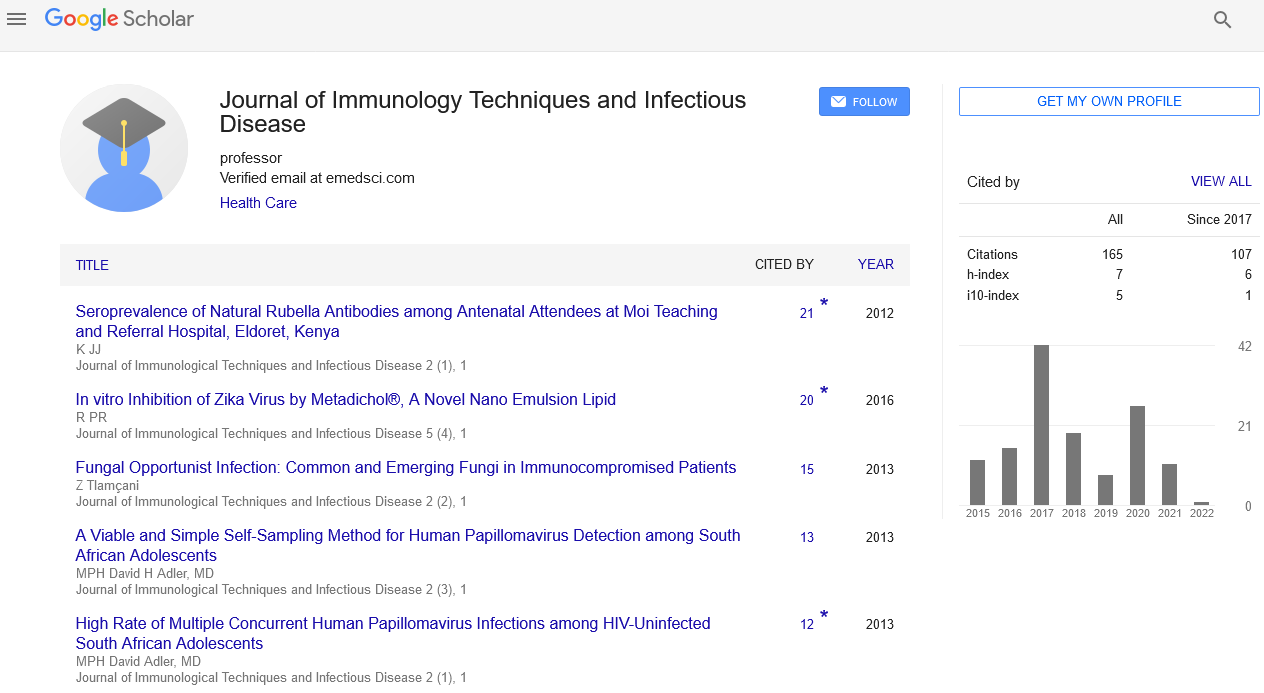Editorial, J Immunol Tech Infect Dis Vol: 11 Issue: 1
Prognostic Value of Dysglycemia in Cerebral Hemorrhage in Patients with Metabolic Syndrome
Anupam Varma*
Department of Virology and Immunology, Amity University, Uttar Pradesh, India
*Corresponding Author:
Anupam Varma
Department of Virology and Immunology, Amity University, Uttar Pradesh, India
E-mail:av.acpv@gmail.com
Received date: 03 January, 2022, Manuscript No: JIDIT-22-57219;
Editor assigned date: 06 January, 2022; PreQC No. JIDIT-22-57219(PQ);
Reviewed date: 19 January, 2022, QC No: JIDIT-22-57219;
Revised date: 31 January, 2022, Manuscript No. JIDIT-22-57219(R);
Published date:08 February, 2022, DOI: 10.4172/ 2329-9541.1000183.
Abstract
A microorganism or microbe is an organism of microscopic size which may exist in its single-celled form or as a colony of cells. The possible existence of unseen microbial life was suspected from ancient times, such as in Jain scriptures from sixth century BC India. The scientific study of microorganisms began with their observation under the microscope in the 1670s by Anton van Leeuwenhoek [1]. In the 1850s, Louis Pasteur found that microorganisms caused food spoilage, debunking the theory of spontaneous generation. In the 1880s, Robert Koch discovered that microorganisms caused the diseases tuberculosis, cholera, diphtheria, and anthrax. Because microorganisms include most unicellular organisms from all three domains of life they can be extremely diverse. Two of the three domains archaea and bacteria, only contain microorganisms [2]. The third domain eukaryota includes all multicellular organisms as well as many unicellular protists and protozoans that are microbes. Some protists are related to animals and some to green plants. There are also many multicellular organisms that are microscopic, namely micro-animals some fungi and some algae, but these are generally not considered microorganisms. Microorganisms can have very different habitats, and live everywhere from the poles to the equator, deserts, geysers, rocks, and the deep sea. Some are adapted to extremes such as very hot or very cold conditions others to high pressure and a few such as deinococcus radiodurans, to high radiation environments. Microorganisms also make up the microbiota found in and on all multicellular organisms. There is evidence that 3.45-billion-year-old Australian rocks once contained microorganisms, the earliest direct evidence of life on earth. Microbes are important in human culture and health in many ways, serving to ferment foods and treat sewage, and to produce fuel, enzymes, and other bioactive compounds. Microbes are essential tools in biology as model organisms and have been put to use in biological warfare and bioterrorism [3]. Microbes are a vital component of fertile soil. In the human body, microorganisms make up the human microbiota, including the essential gut flora. The pathogens responsible for many infectious diseases are microbes and, as such, are the target of hygiene measures.
Keywords: Metabolic Syndrome
Introduction
A microorganism or microbe is an organism of microscopic size which may exist in its single-celled form or as a colony of cells. The possible existence of unseen microbial life was suspected from ancient times, such as in Jain scriptures from sixth century BC India. The scientific study of microorganisms began with their observation under the microscope in the 1670s by Anton van Leeuwenhoek [1]. In the 1850s, Louis Pasteur found that microorganisms caused food spoilage, debunking the theory of spontaneous generation. In the 1880s, Robert Koch discovered that microorganisms caused the diseases tuberculosis, cholera, diphtheria, and anthrax. Because microorganisms include most unicellular organisms from all three domains of life they can be extremely diverse. Two of the three domains archaea and bacteria, only contain microorganisms [2]. The third domain eukaryota includes all multicellular organisms as well as many unicellular protists and protozoans that are microbes. Some protists are related to animals and some to green plants. There are also many multicellular organisms that are microscopic, namely micro-animals some fungi and some algae, but these are generally not considered microorganisms. Microorganisms can have very different habitats, and live everywhere from the poles to the equator, deserts, geysers, rocks, and the deep sea. Some are adapted to extremes such as very hot or very cold conditions others to high pressure and a few such as deinococcus radiodurans, to high radiation environments. Microorganisms also make up the microbiota found in and on all multicellular organisms. There is evidence that 3.45-billion-year-old Australian rocks once contained microorganisms, the earliest direct evidence of life on earth. Microbes are important in human culture and health in many ways, serving to ferment foods and treat sewage, and to produce fuel, enzymes, and other bioactive compounds. Microbes are essential tools in biology as model organisms and have been put to use in biological warfare and bioterrorism [3]. Microbes are a vital component of fertile soil. In the human body, microorganisms make up the human microbiota, including the essential gut flora. The pathogens responsible for many infectious diseases are microbes and, as such, are the target of hygiene measures.
Single-celled microorganisms were the first forms of life on earth to develop from the oceans around 3.5 billion years ago. Further onwards, evolution came to a halt during the Precambrian era as all organisms were transformed into newer microorganisms [4]. The possible existence of microscopic organisms was discussed for many centuries before their discovery in the seventeenth century. By the fifth century BC, the jains of present-day india postulated the existence of tiny organisms called nigodas. These nigodas are said to be born in clusters; they live everywhere, including the bodies of plants, animals, and people; and their life lasts only for a fraction of a second. According to the jain leader mahavira, the humans destroy these nigodas on a massive scale, when they eat, breathe sit and move. Many modern jains assert that mahavira's teachings presage the existence of microorganisms as discovered by modern science [5]. The earliest known idea to indicate the possibility of diseases spreading by yet unseen organisms was that of the roman scholar and warns against locating a homestead near a swamp and because there are bred certain minute creatures that cannot be seen by the eyes, which float in the air and enter the body through the mouth and nose and they cause serious diseases. It is incorrect to assume that diseases appear one by one in humans. Disease infects by spreading from one person to another. This infection occurs through seeds that are so small they cannot be seen but are alive [6]. In 1546, Girolamo Fracastoro proposed that epidemic diseases were caused by transferable seedlike entities that could transmit infection by direct or indirect contact or even without contact over long distances. Antonie van is considered to be one of the fathers of microbiology. He was the first in 1673 to discover and conduct scientific experiments with microorganisms, using simple single-lensed microscopes of his own design [7,8].
Classification and Structure
Microorganisms can be found almost anywhere on earth. Bacteria and archaea are almost always microscopic, while a number of eukaryotes are also microscopic, including most protists, some fungi, as well as some micro-animals and plants [9]. Viruses are generally regarded as not living and therefore not considered as microorganisms, although a subfield of microbiology is virology, the study of viruses. Single-celled microorganisms were the first forms of life to develop on earth, approximately 3.5 billion years ago. Further evolution was slow, and for about 3 billion years in the Precambrian eon, much of the history of life on earth all organisms were microorganisms. Bacteria, algae and fungi have been identified in amber that is 220 million years old, which shows that the morphology of microorganisms has changed little since at least the triassic period [10].
Plants and Soil
The nitrogen cycle in soils depends on the fixation of atmospheric nitrogen. This is achieved by a number of diazotrophs. One way this can occur is in the root nodules of legumes that contain symbiotic bacteria of the genera rhizobium, mesorhizobium, sinorhizobium, bradyrhizobium, and azorhizobium. The roots of plants create a narrow region known as the rhizosphere that supports many microorganisms known as the root microbiome. These microorganisms in the root microbiome are able to interact with each other and surrounding plants through signals and cues. For example, mycorrhizal fungi are able to communicate with the root systems of many plants through chemical signals between both the plant and fungi. This results in a mutualistic symbiosis between the two. However, these signals can be eavesdropped by other microorganisms, such as the soil bacteria, myxococcus xanthus, which preys on other bacteria. Eavesdropping, or the interception of signals from unintended receivers, such as plants and microorganisms, can lead to large-scale, evolutionary consequences. For example, signaler-receiver pairs, like plant-microorganism pairs, may lose the ability to communicate with neighboring populations because of variability in eavesdroppers. In adapting to avoid local eavesdroppers, signal divergence could occur and thus, lead to the isolation of plants and microorganisms from the inability to communicate with other populations.
References
- Schopf WJ, Kitajima K, Michael J, Kudryavtsev A, Anatolly B, et al. (2017) SIMS analyses of the oldest known assemblage of microfossils document their taxon-correlated carbon isotope compositions. Proc Natl Acad Sci 1: 53-58. [Crossref], [Google Scholar] [Indexed]
- Nutton V (1990) The reception of fracastoro's theory of contagion: The seed that fell among thorns. Osiris 6: 196-234. [Crossref], [Google Scholar], [Indexed]
- Leeuwenhoek A (1753) Concerning the worms in sheeps livers, gnats, and animalcula in the excrements of frogs. Philosophical Transactions 22: 509-51. [Crossref], [Google Scholar]
- 4. Lane N (2015) The unseen world: Reflections on leeuwenhoek (1677) Concerning little animal. Philos Trans R Soc Lond B Biol Sci 19: 1666. [Crossref], [Google Scholar], [Indexed]
- Gest H (2005) The remarkable vision of robert hooke (1635â??1703): First observer of the microbial world. Perspect Biol Med 48: 266-272. [Crossref], [Google Scholar], [Indexed]
- Rothschild LJ (1989) Protozoa, protista, protoctista: What's in a name. J Hist Biol 22: 277-305. [Crossref], [Google Scholar], [Indexed]
- Schopf J (2006) Fossil evidence of archaean life. Philos Trans R Soc Lond B Biol Sci 361: 869- 885. [Crossref], [Google Scholar], [Indexed]
- Altermann W, Kazmierczak J (2003) Archean microfossils: A reappraisal of early life on earth. Res Microbiol 154: 611-617. [Crossref], [Google Scholar], [Indexed]
- Cavalier-Smith T (2006) Cell evolution and earth history: Stasis and revolution. Philos Trans R Soc Lond B Biol Sci 361: 969-1006. [Crossref], [Google Scholar], [Indexed]
- Schopf J (1994) Disparate rates, differing fates: Tempo and mode of evolution changed from the precambrian to the phanerozoic. Proc Natl Acad Sci 91: 6735-674. [Crossref], [Google Scholar], [Indexed]
 Spanish
Spanish  Chinese
Chinese  Russian
Russian  German
German  French
French  Japanese
Japanese  Portuguese
Portuguese  Hindi
Hindi 
